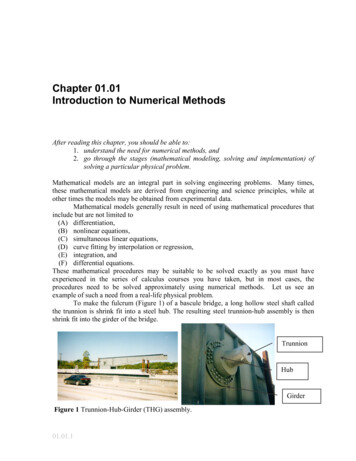
Transcription
Chapter 01.01Introduction to Numerical MethodsAfter reading this chapter, you should be able to:1. understand the need for numerical methods, and2. go through the stages (mathematical modeling, solving and implementation) ofsolving a particular physical problem.Mathematical models are an integral part in solving engineering problems. Many times,these mathematical models are derived from engineering and science principles, while atother times the models may be obtained from experimental data.Mathematical models generally result in need of using mathematical procedures thatinclude but are not limited to(A) differentiation,(B) nonlinear equations,(C) simultaneous linear equations,(D) curve fitting by interpolation or regression,(E) integration, and(F) differential equations.These mathematical procedures may be suitable to be solved exactly as you must haveexperienced in the series of calculus courses you have taken, but in most cases, theprocedures need to be solved approximately using numerical methods. Let us see anexample of such a need from a real-life physical problem.To make the fulcrum (Figure 1) of a bascule bridge, a long hollow steel shaft calledthe trunnion is shrink fit into a steel hub. The resulting steel trunnion-hub assembly is thenshrink fit into the girder of the bridge.TrunnionHubGirderFigure 1 Trunnion-Hub-Girder (THG) assembly.01.01.1
01.01.2Chapter 01.01This is done by first immersing the trunnion in a cold medium such as a dryice/alcohol mixture. After the trunnion reaches the steady state temperature of the coldmedium, the trunnion outer diameter contracts. The trunnion is taken out of the medium andslid through the hole of the hub (Figure 2).Figure 2 Trunnion slided through the hub after contractingWhen the trunnion heats up, it expands and creates an interference fit with the hub.In 1995, on one of the bridges in Florida, this assembly procedure did not work as designed.Before the trunnion could be inserted fully into the hub, the trunnion got stuck. Luckily, thetrunnion was taken out before it got stuck permanently. Otherwise, a new trunnion and hubwould needed to be ordered at a cost of 50,000. Coupled with construction delays, the totalloss could have been more than a hundred thousand dollars.Why did the trunnion get stuck? This was because the trunnion had notcontracted enough to slide through the hole. Can you find out why?A hollow trunnion of outside diameter 12.363" is to be fitted in a hub of innerdiameter 12.358" . The trunnion was put in dry ice/alcohol mixture (temperature of the fluid- dry ice/alcohol mixture is 108 F ) to contract the trunnion so that it can be slid through thehole of the hub. To slide the trunnion without sticking, a diametrical clearance of at least0.01" is required between the trunnion and the hub. Assuming the room temperature is80 F , is immersing the trunnion in dry-ice/alcohol mixture a correct decision?To calculate the contraction in the diameter of the trunnion, the thermal expansioncoefficient at room temperature is used. In that case the reduction D in the outer diameterof the trunnion is(1) D Dα TwhereD outer diameter of the trunnion,α coefficient of thermal expansion coefficient at room temperature, and T change in temperature,GivenD 12.363"α 6.47 10 6 in/in/ F at 80 F T T fluid Troom 108 80
Introduction to Numerical Methodswhere01.01.3 188 FT fluid temperature of dry-ice/alcohol mixtureTroom room temperaturethe reduction in the outer diameter of the trunnion is given by D (12.363) 6.47 10 6 ( 188) 0.01504"So the trunnion is predicted to reduce in diameter by 0.01504" . But, is this enoughreduction in diameter? As per specifications, the trunnion needs to contract by trunnion outside diameter - hub inner diameter diametric clearance 12.363 – 12.358 0.01 0.015"So according to his calculations, immersing the steel trunnion in dry-ice/alcoholmixture gives the desired contraction of greater than 0.015" as the predicted contraction is0.01504" . But, when the steel trunnion was put in the hub, it got stuck. Why did thishappen? Was our mathematical model adequate for this problem or did we create amathematical error?As shown in Figure 3 and Table 1, the thermal expansion coefficient of steeldecreases with temperature and is not constant over the range of temperature the trunniongoes through. Hence, Equation (1) would overestimate the thermal contraction.()7.00E-06Coefficient of ThermalExpancion 1.00E-06-400-350-300-250-200-1500.00E 00-500-10050100150oTem perature ( F)Figure 3 Varying thermal expansion coefficient as a function of temperature for caststeel.The contraction in the diameter of the trunnion for which the thermal expansion coefficientvaries as a function of temperature is given byT fluid D D αdTTroom(2)So one needs to curve fit the data to find the coefficient of thermal expansion as a function oftemperature. This is done by regression where we best fit a curve through the data given inTable 1. In this case, we may fit a second order polynomial(3)α a0 a1 T a2 T 2
01.01.4Chapter 01.01Table 1 Instantaneous thermal expansion coefficient as a function of temperature.InstantaneousTemperatureThermal Expansionμin/in/ F 2.76-3402.45The values of the coefficients in the above Equation (3) will be found by polynomialregression (we will learn how to do this later in Chapter 06.04). At this point we are justgoing to give you these values and they are 6 a 0 6.0150 10 a 6.1946 10 9 1 a 2 1.2278 10 11 to give the polynomial regression model (Figure 4) asα a0 a1T a2T 2 6.0150 10 6 6.1946 10 9 T 1.2278 10 11 T 2Knowing the values of a 0 , a1 and a 2 , we can then find the contraction in the trunniondiameter asT fluid D D (a0 a1T a2T 2 )dTTroom2 D[a0 (T fluid Troom ) a12(T fluid Troom )23 a23(T fluid Troom )3](4)
Introduction to Numerical Methods01.01.5which gives22 6 9 (( 108) (80) ) 6.015010(10880)6.194610 2 D 12.363 33 12 (( 108) (80) ) 1.2278 10 3 0.013689"Coefficient of thermal expansion(µ 200-1000100200oTemperature ( F)Figure 4 Second order polynomial regression model for coefficient of thermal expansion asa function of temperature.What do we find here? The contraction in the trunnion is not enough to meet the requiredspecification of 0.015" .So here are some questions that you may want to ask yourself?1. What if the trunnion were immersed in liquid nitrogen (boilingtemperature 321 F )? Will that cause enough contraction in the trunnion?2. Rather than regressing the thermal expansion coefficient data to a second orderpolynomial so that one can find the contraction in the trunnion OD, how would youuse Trapezoidal rule of integration for unequal segments? What is the relativedifference between the two results?3. We chose a second order polynomial for regression. Would a different orderpolynomial be a better choice for regression? Is there an optimum order ofpolynomial you can find?As mentioned at the beginning of this chapter, we generally see mathematicalprocedures that require the solution of nonlinear equations, differentiation, solution ofsimultaneous linear equations, interpolation, regression, integration, and differentialequations. A physical example to illustrate the need for each of these mathematicalprocedures is given in the beginning of each chapter. You may want to look at them now tounderstand better why we need numerical methods in everyday life.
01.01.6Chapter 01.01INTRODUCTION, APPROXIMATION AND ERRORSTopicIntroduction to Numerical MethodsSummary Textbook notes of Introduction to Numerical MethodsMajorGeneral EngineeringAuthorsAutar KawDateJanuary 27, 2011Web Site http://numericalmethods.eng.usf.edu
Introduction to Numerical Methods . After reading this chapter, you should be able to: 1. understand the need for numerical methods, and 2. go through the stages (mathematical modeling, solving and implementation) of solving a particular physical problem. Mathematical models are an integral part in solving engineering problems. Many times,











